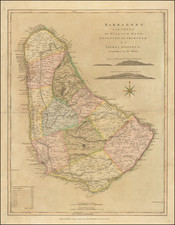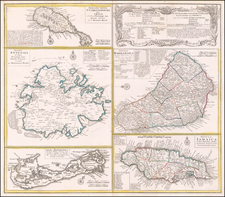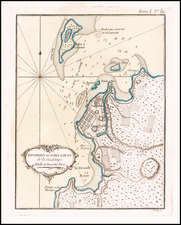The "Map of the Island of Barbados," drawn by Reverend Griffith Hughes, is a detailed and informative representation of the island in the 18th century. Based on actual surveys and personal observations by Hughes, the map offers an in-depth view of the island's geography and societal makeup.
The map clearly outlines the eleven parishes of Barbados, each demarcated with distinct precision. The towns are marked, highlighting their spatial relationships to each other and the rest of the island's topography. Significant features, such as churches and forts, are dotted across the map, serving as reminders of the island's colonial era and religious landscape.
More than just human settlements, the map also spotlights the vibrant sugar industry that dominated Barbados in the 18th century. Detailed illustrations of sugar works, mills, and plantations, showcase the island's primary economic engine. The web of roads connecting these places gives a sense of the logistic network and the labor-intensive nature of the industry.
The rivers of Barbados, while not abundant due to the island's geological characteristics, are carefully outlined. They often stretch from the highlands towards the coast, hinting at their importance for irrigation in the agriculture-centered economy.
Mountainous areas, though not as prevalent as on other Caribbean islands, are effectively depicted with shading and hachures to represent their relative heights. This gives the viewer a sense of the island's terrain, which, while not exceptionally steep, does feature gentle slopes and undulations.
Barbados in the 18th century was a bustling hub of trade and commerce. It was one of the wealthiest of the British colonies, thanks to its sugar, rum, and molasses production, as evidenced by the numerous plantations scattered across Hughes's map. African slaves were the backbone of these labor-intensive industries, though their existence is only implicitly suggested through the extensive infrastructure depicted.
Hughes, serving as the rector of St. Lucy's Parish from 1736, used his position to study and record the island's natural features, plants, and wildlife. His keen observations and meticulous detailing offer an invaluable perspective on Barbados's physical and human geography during this period.
This map is more than a navigational aid; it is an historical document that paints a picture of an era. It offers insights into the development of Barbados, revealing the intertwining of geography, industry, and colonial rule. Through Hughes's diligent work, we glimpse the 18th century Barbadian landscape, an island shaped as much by human endeavor as it is by its natural boundaries.
The Reverend Griffith Hughes (fl. 1707-1758), was a naturalist and author. He served as the rector of St. Lucy's Parish in Barbados from 1736 until his return to London. While on Barbados, he recorded his observations of the natural features, plants, and wildlife over a period of several years.
Thomas Jefferys (ca. 1719-1771) was a prolific map publisher, engraver, and cartographer based in London. His father was a cutler, but Jefferys was apprenticed to Emanuel Bowen, a prominent mapmaker and engraver. He was made free of the Merchant Taylors’ Company in 1744, although two earlier maps bearing his name have been identified.
Jefferys had several collaborators and partners throughout his career. His first atlas, The Small English Atlas, was published with Thomas Kitchin in 1748-9. Later, he worked with Robert Sayer on A General Topography of North America (1768); Sayer also published posthumous collections with Jefferys' contributions including The American Atlas, The North-American Pilot, and The West-India Atlas.
Jefferys was the Geographer to Frederick Prince of Wales and, from 1760, to King George III. Thanks especially to opportunities offered by the Seven Years' War, he is best known today for his maps of North America, and for his central place in the map trade—he not only sold maps commercially, but also imported the latest materials and had ties to several government bodies for whom he produced materials.
Upon his death in 1771, his workshop passed to his partner, William Faden, and his son, Thomas Jr. However, Jefferys had gone bankrupt in 1766 and some of his plates were bought by Robert Sayer (see above). Sayer, who had partnered in the past with Philip Overton (d. 1751), specialized in (re)publishing maps. In 1770, he partnered with John Bennett and many Jefferys maps were republished by the duo.









![[ Rare Sailing Directions ] Barbados. W.I. Compiled from Admiralty Sheet 1884. Hanschell & Co. Sail and Steam Agents Barbados [with] Bridgetown](https://storage.googleapis.com/raremaps/img/small/99569.jpg)
![Martinico [and] Dominica](https://storage.googleapis.com/raremaps/img/small/85250.jpg)
![Carta General de las Islas Antillas Menores [North sheet]](https://storage.googleapis.com/raremaps/img/small/93244.jpg)


